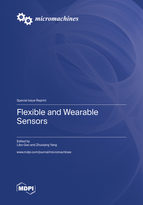Flexible and Wearable Sensors
A special issue of Micromachines (ISSN 2072-666X). This special issue belongs to the section "A:Physics".
Deadline for manuscript submissions: closed (30 June 2023) | Viewed by 57254
Special Issue Editors
Interests: flexible sensor; flexible and wearable electronics; 3D printing
Special Issues, Collections and Topics in MDPI journals
Interests: flexible electronics; MEMS; flexible sensor
Special Issues, Collections and Topics in MDPI journals
Special Issue Information
Dear Colleagues,
Due to their favorable flexibility and adaptability, flexible and wearable electronics have exhibited enormous potential in broad prospects on human–machine interaction, robotics, and healthcare monitoring. Consequently, they have become one of the most attractive and rapidly growing areas of novel interdisciplinary research. As the core components of flexible electronics, the excellent flexibility sensing performance of flexible and wearable sensors are important guarantees for flexible wearable electronics, which have become the focus of domestic and international research. Accordingly, this Special Issue seeks to showcase research papers, short communications, and review articles that focus on:
- Novel structural designs, material fabrication, signal processing, and modeling of flexible and wearable sensors based on all kinds of mechanisms;
- MEMS technique process of wearable and flexible sensors and simulation process of theoretical modeling;
- Multiple application scenarios in multivariable flexible and wearable sensor systems.
Dr. Libo Gao
Dr. Zhuoqing Yang
Guest Editors
Manuscript Submission Information
Manuscripts should be submitted online at www.mdpi.com by registering and logging in to this website. Once you are registered, click here to go to the submission form. Manuscripts can be submitted until the deadline. All submissions that pass pre-check are peer-reviewed. Accepted papers will be published continuously in the journal (as soon as accepted) and will be listed together on the special issue website. Research articles, review articles as well as short communications are invited. For planned papers, a title and short abstract (about 100 words) can be sent to the Editorial Office for announcement on this website.
Submitted manuscripts should not have been published previously, nor be under consideration for publication elsewhere (except conference proceedings papers). All manuscripts are thoroughly refereed through a single-blind peer-review process. A guide for authors and other relevant information for submission of manuscripts is available on the Instructions for Authors page. Micromachines is an international peer-reviewed open access monthly journal published by MDPI.
Please visit the Instructions for Authors page before submitting a manuscript. The Article Processing Charge (APC) for publication in this open access journal is 2600 CHF (Swiss Francs). Submitted papers should be well formatted and use good English. Authors may use MDPI's English editing service prior to publication or during author revisions.
Keywords
- flexible sensors
- electronic skin
- flexible electronics
- wearable electronics
- MEMS wearable applications
Related Special Issues
- Flexible and Wearable Sensors, 2nd Edition in Micromachines (13 articles)
- Flexible and Wearable Sensors, 3rd Edition in Micromachines (2 articles)








